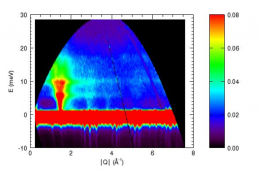The Spin Doctor

An electron spin can be compared to the needle of a compass that points either north or south. Some electrons in a full shell point up, canceling out the electromagnetic fields of an equal number of electrons that point down.
The field of an electron spin that is not canceled in an unfilled shell makes some elements magnetic -- iron, nickel, chromium, vanadium, and the rare earths. In the ARCS experiment at SNS, the novel material being probed with neutrons is a crystalline powder of a strontium-chromium-oxygen (SrCr2O4) compound, an antiferromagnetic material made at the Institute for Quantum Matter.
"We are studying materials with strongly correlated electrons, where each electron coordinates its motion with the immediate surroundings beyond a response to the average," Collin Broholm, professor of physics at Johns Hopkins University, explained. "As a social analog, consider a crowd milling around in an airport. If each individual is not affected by the details of how people look and behave but just senses an anonymous crowd, we call this response mean field behavior, which is not so exciting.
"Instead, we are interested in electron spins that form dynamic clusters in response to interactions with other electrons. The social analog could be the spontaneous formation of groups of individuals chatting with each other after a frustrating flight delay is announced. To understand electron correlations we use neutrons, because their magnetic moment makes them exquisitely sensitive to electron spins."
The SrCr2O4 crystalline structure consists of layers of chromium with oxygen atoms on its vertices; the Cr layers are separated by strontium atoms. In such compounds, the chromium atoms can be arranged in a square or triangular network. Owing to the so-called Pauli exclusion principle, the spins associated with each Cr atom seek anti-parallel alignment. In a square network, the spins can form a robust up/down (black/white) checkerboard pattern where no two up-spins are neighbors. In SrCr2O4, however, the chromium atoms form a triangular arrangement where up spins cannot be kept apart.
"Make yourself a triangular checkerboard and you will experience the frustration of electron spins as you try to color triangles black and white without neighboring white or neighboring black triangles," Broholm explained. "You'll find it's impossible! We are interested in what replaces the checkerboard pattern when we force frustration upon the electron spins by placing them on a triangular lattice. The long-term goal is for superconductivity to arise in the wake of frustrated magnetism.
"The patterns of scattering obtained from the ARCS instrument provide unique information about spin correlations that we need to make progress," Broholm said. "We infer the arrangement of electron spins based on how neutrons are scattered."
As tiny magnets, neutrons are influenced by the time-dependent magnetic fields of fluctuating electron spins. The fields affect the energy and angle at which neutrons are scattered, and the scattering effects can be accurately cataloged in a large bank of neutron detectors.
Diagnosing the effects of electron spins on each other and taming them for our use take more than a few spin doctors-neutrons and giant detectors at the SNS are also required.
Provided by Oak Ridge National Laboratory















